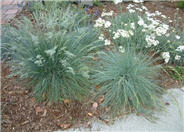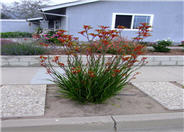
Common name:Elija Blue Fescue
Botanical name:Festuca glauca 'Elija Blue'
The 'Elijah Blue' is a dwarf variety with gray blue (but sometimes white-looking) foliage. It should receive sun and little summer watering.

Common name:Blue Fescue
Botanical name:Festuca glauca
This ground cover/grass will grow less than 1' tall and has small, blue green leaves.

Common name:Brown Sedge
Botanical name:Carex testacea
Brown Sedge is an evergreen perennial that reaches 2' tall bearing very narrow, coppery brown leaves splitting to hair-like threads at their tips, and continuing to grow to 4'-8' in length. This plant should be grown in sun with little or no summer watering.

Common name:Mother-of-Thyme, Creeping Thyme
Botanical name:Thymus serpyllum
This evergreen ground cover needs full sun to light shade. It grows to 3" tall, forming a dense, thick mat. It needs well-drained, light soil. Creeping Thyme is considered drought tolerant. The foliage is dark green and slightly hairy. It has a pleasant, minty fragrance when crushed, though not considered for culinary uses. Flowers are lilac purple and bloom in the summer. It attracts bees and butterflies.

Common name:Dymondia, Rock Ditty
Botanical name:Dymondia margaretae
This foliage is gray/green/silvery; it is a very dense, mat forming ground cover. It tolerates drought, cold, salt spray and poor soils. It's deep rooted and produces small, inconspicuous yellow flowers. Rock Ditty is great for use in between stepping stones or pavers.

Common name:Red Cross Kangaroo Paws
Botanical name:Anigozanthos 'Red Cross'
Red Cross Kangaroo Paws has showy, tall (4'-5'), multi- branched stems with rich red color on both flowers and stems. The flowers have a green interior. It is fast growing.

Common name:Trailing Germander
Botanical name:Teucrium X lucidrys
This mini-shrub with small, shiny, dark green leaves on woody stems can be sheared and shaped. The stems trail and rise to 24", with lovely, reddish purple flowers between the upper leaves. It can be used as a low hedge plant in herbal knot gardens. To encourage branching, it should be pruned in the spring.
The Right Plant Right Place
Putting the right plants in the right places in the right groupings is both the challenge and art of good landscape design.
Click in the green box for more information
| Designer: | Green Island in the Driveway |
Photographer: GardenSoft |
Soils and Compost:
Maintain a two to four inch layer of mulch on the soil surface to reduce weeds, infiltrate rain water, and reduce compaction.
Water Saving Tip:
Group plants in your garden according to their water needs (hydrozone).
Integrated Pest Management:
Attract, or buy beneficial insects such as ladybugs and lacewings to control pest outbreaks in your garden.
